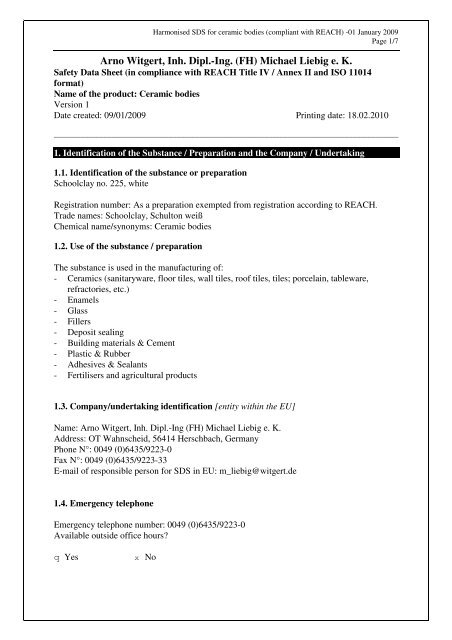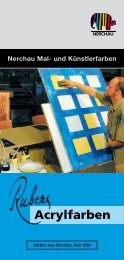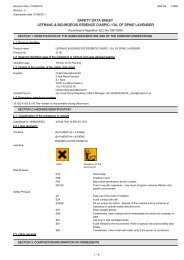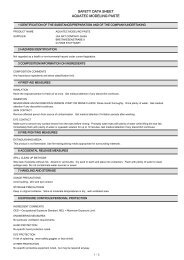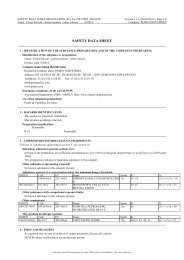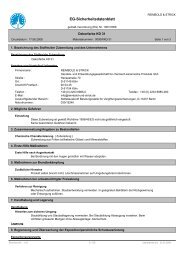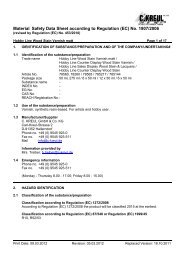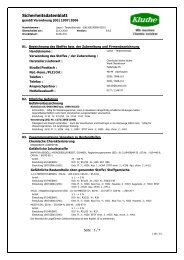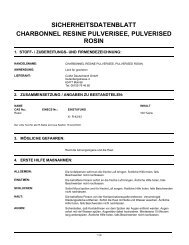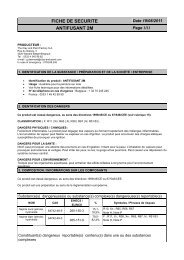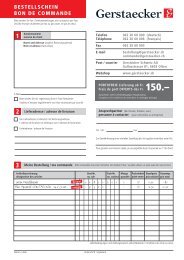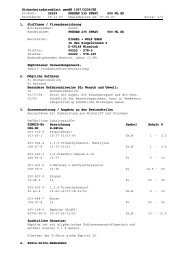Arno Witgert, Inh. Dipl.-Ing. (FH) Michael Liebig e. K. - Gerstaecker
Arno Witgert, Inh. Dipl.-Ing. (FH) Michael Liebig e. K. - Gerstaecker
Arno Witgert, Inh. Dipl.-Ing. (FH) Michael Liebig e. K. - Gerstaecker
You also want an ePaper? Increase the reach of your titles
YUMPU automatically turns print PDFs into web optimized ePapers that Google loves.
Harmonised SDS for ceramic bodies (compliant with REACH) -01 January 2009<br />
Page 1/7<br />
<strong>Arno</strong> <strong>Witgert</strong>, <strong>Inh</strong>. <strong>Dipl</strong>.-<strong>Ing</strong>. (<strong>FH</strong>) <strong>Michael</strong> <strong>Liebig</strong> e. K.<br />
Safety Data Sheet (in compliance with REACH Title IV / Annex II and ISO 11014<br />
format)<br />
Name of the product: Ceramic bodies<br />
Version 1<br />
Date created: 09/01/2009 Printing date: 18.02.2010<br />
__________________________________________________________________________________________<br />
1. Identification of the Substance / Preparation and the Company / Undertaking<br />
1.1. Identification of the substance or preparation<br />
Schoolclay no. 225, white<br />
Registration number: As a preparation exempted from registration according to REACH.<br />
Trade names: Schoolclay, Schulton weiß<br />
Chemical name/synonyms: Ceramic bodies<br />
1.2. Use of the substance / preparation<br />
The substance is used in the manufacturing of:<br />
- Ceramics (sanitaryware, floor tiles, wall tiles, roof tiles, tiles; porcelain, tableware,<br />
refractories, etc.)<br />
- Enamels<br />
- Glass<br />
- Fillers<br />
- Deposit sealing<br />
- Building materials & Cement<br />
- Plastic & Rubber<br />
- Adhesives & Sealants<br />
- Fertilisers and agricultural products<br />
1.3. Company/undertaking identification [entity within the EU]<br />
Name: <strong>Arno</strong> <strong>Witgert</strong>, <strong>Inh</strong>. <strong>Dipl</strong>.-<strong>Ing</strong> (<strong>FH</strong>) <strong>Michael</strong> <strong>Liebig</strong> e. K.<br />
Address: OT Wahnscheid, 56414 Herschbach, Germany<br />
Phone N°: 0049 (0)6435/9223-0<br />
Fax N°: 0049 (0)6435/9223-33<br />
E-mail of responsible person for SDS in EU: m_liebig@witgert.de<br />
1.4. Emergency telephone<br />
Emergency telephone number: 0049 (0)6435/9223-0<br />
Available outside office hours?<br />
q Yes<br />
x No
Harmonised SDS for ceramic bodies (compliant with REACH) -01 January 2009<br />
Page 2/7<br />
2. Hazards Identification<br />
Ceramic bodies do not meet the criteria for classification as dangerous as defined in Directive 67/548 EEC.<br />
The product does give potential for generation of respirable dust during handling and use. Dust may contain<br />
respirable crystalline silica. Prolonged and or massive inhalation of respirable crystalline silica dust may cause<br />
lung fibrosis, commonly referred to as silicosis. Principal symptoms of lung fibrosis are cough and<br />
breathlessness. Occupational exposure to respirable dust and respirable crystalline silica should be monitored and<br />
controlled.<br />
3. Composition / Information on <strong>Ing</strong>redients<br />
3.1. Chemical composition:<br />
Kaolinatic clays, hydrous aluminium silicate - Al 2 Si 2 O 5 (OH) 4<br />
May contain mineral or chemical additives.<br />
3.2 Components:<br />
Name % by weight CAS-No EINECS No EU Classification<br />
Kaolinitic Clay 100% 999999-99-4 310-127-6 No classification<br />
3.3. Components presenting a health hazard:<br />
Kaolinitic clay may contain crystalline silica (not listed in Annex I of Directive 67/548/EEC).<br />
4. First aid measures<br />
No action to be avoided, nor special instructions for rescuers.<br />
Eye contact<br />
For direct contact, flush the affected eye with clean water. If irritation develops, seek medical attention.<br />
<strong>Ing</strong>estion<br />
No special first aid measure<br />
<strong>Inh</strong>alation<br />
Remove from source to fresh air. If symptoms occur, seek medical attention<br />
Skin contact<br />
Wash with soap and water, rinse after washing<br />
5. Fire-fighting measures<br />
Non flammable, non explosive. No hazardous releases in case of fire.<br />
6. Accidental release measures<br />
Personal precautions<br />
In case of exposure to prolonged or high level of airborne dust, wear a personal respirator in compliance with<br />
national legislation.<br />
Environmental precautions<br />
No special requirement<br />
Methods for cleaning up<br />
Avoid dry sweeping and use water spraying or ventilated vacuum system to prevent dust formation.
Harmonised SDS for ceramic bodies (compliant with REACH) -01 January 2009<br />
Page 3/7<br />
7. Handling and Storage<br />
7.1. Safe Handling Advice<br />
No special handling precautions are required. Good housekeeping and dust prevention procedures should be<br />
followed to minimise dust generation and accumulation. In case of insufficient ventilation, wear suitable<br />
respiratory equipment. Ceramic bodies may be handled with bare hands without the use of gloves however gloves<br />
are recommended to prevent drying of skin. An apron may be worn to minimize exposure to the body.<br />
7.2. Storage<br />
In case of plastic and liquid ceramic bodies, we recommend a frost-free, cool and dark storage. Improper storage<br />
can lead to the development of algae and / or mold. Provide appropriate ventilation and store bags such as to<br />
prevent any accidental damage. Prevent bags from being wet with drenching amounts of water to maintain the<br />
packaging integrity.<br />
7.3. Specific Use(s)<br />
No special technical measures or precautions. Apply above handling advice when mixing with other substances.<br />
8. Exposure controls / Personal protection<br />
8.1. Exposure limit values<br />
Respect regulatory provisions for dust (total and respirable), and for respirable crystalline silica dust. Please refer<br />
to the annex 1 for the appropriate national exposure limit values.<br />
8.2. Exposure controls<br />
8.2.1. OCCUPATIONAL EXPOSURE CONTROLS<br />
Use local exhaust ventilation to keep airborne concentrations of dust below permissible exposure levels. Wash<br />
hands before breaks and at the end of the workday. Remove and wash soiled clothing.<br />
- Respiratory protection<br />
In case of prolonged exposure to dust wear a personal respirator in compliance with national<br />
Legislation!<br />
8.2.2. ENVIRONMENTAL EXPOSURE CONTROLS<br />
No special requirement<br />
9. Physical and chemical properties<br />
9.1. General information<br />
Physical state<br />
Colour<br />
Odour<br />
solid (bulk, lumps, pellets, granulate or powder)<br />
grey-white<br />
odourless<br />
9.2. Important health, safety and environmental information<br />
Specific gravity 0.7 - 2.6 g/cm 3<br />
Melting temperature > 1700°C<br />
Boiling point<br />
Not applicable<br />
Flash point<br />
Non flammable<br />
Explosion hazard<br />
Non explosive<br />
Solubility in water<br />
Negligible (
Harmonised SDS for ceramic bodies (compliant with REACH) -01 January 2009<br />
Page 4/7<br />
11. Toxicological information<br />
11.1 Acute effects<br />
Skin irritation data<br />
No irritation to skin<br />
Eye irritation data<br />
Mild irritant to eyes<br />
11.2 Chronic effects<br />
Prolonged inhalation of respirable crystalline silica<br />
In 1997, IARC (the International Agency for Research on Cancer) concluded that crystalline silica inhaled from<br />
occupational sources can cause lung cancer in humans. However it pointed out that not all industrial<br />
circumstances, nor all crystalline silica types, were to be incriminated. (IARC Monographs on the evaluation of<br />
the carcinogenic risks of chemicals to humans, Silica, silicates dust and organic fibres, 1997, Vol. 68, IARC,<br />
Lyon, France.)<br />
In June 2003, SCOEL (the EU Scientific Committee on Occupational Exposure Limits) concluded that the main<br />
effect in humans of the inhalation of respirable crystalline silica dust is silicosis. “There is sufficient information<br />
to conclude that the relative risk of lung cancer is increased in persons with silicosis (and, apparently, not in<br />
employees without silicosis exposed to silica dust in quarries and in the ceramic industry). Therefore preventing<br />
the onset of silicosis will also reduce the cancer risk…“ (SCOEL SUM Doc 94-final, June 2003)<br />
There is a body of evidence supporting the fact that increased cancer risk would be limited to people already<br />
suffering from silicosis. Worker protection against silicosis should be assured by respecting the existing<br />
regulatory occupational exposure limits and implementing additional risk management measures where required<br />
(see section 16 below).<br />
12. Ecological information<br />
No specific adverse effect known.<br />
Not persistent, not bioaccumulative.<br />
13. Disposal considerations<br />
Waste from residues / unused products<br />
Can be landfilled in compliance with local regulations.<br />
Waste-designation in Germany: waste of sand and clay<br />
Waste code according to the European waste list: No 010409<br />
The material should be buried to prevent airborne respirable dust being emitted. Where possible, recycling<br />
should be preferred to disposal.<br />
Packaging<br />
No specific requirements. In all cases dust formation from residues in the packaging should be avoided and<br />
suitable worker protection be assured. Recycling and disposal of packaging should be carried out by a suitable<br />
waste management company.<br />
14. Transport information<br />
No special precaution required under the regulation on transport of dangerous goods. Avoid dust spreading.<br />
15. Regulatory information<br />
National legislation/requirements:<br />
Not known.
Harmonised SDS for ceramic bodies (compliant with REACH) -01 January 2009<br />
Page 5/7<br />
16. Other information<br />
Dioxins<br />
The material may contain trace amounts (parts per trillion) of naturally occurring dioxin congeners (PCDD,<br />
PCDF) including TCDD. 2,3,7,8. TCDD has been classified as a known human carcinogen by the IARC in<br />
Monograph 69 (1997). If this material is used for food, feed, or cosmetic purposes, it is highly recommended to<br />
check whether it fulfils the requirements of relevant legislation, in particular with regards to dioxins content.<br />
Training<br />
Workers must be informed of the presence of crystalline silica and trained in the proper use and handling of this<br />
product as required under applicable regulations.<br />
Social Dialogue on Respirable Crystalline Silica<br />
A multi-sectoral social dialogue agreement on Workers Health Protection through the Good Handling and Use<br />
of Crystalline Silica and Products Containing it was signed on 25 April 2006. This autonomous agreement,<br />
which receives the European Commission’s financial support, is based on a Good Practices Guide. The<br />
requirements of the Agreement came into force on 25 October 2006. The Agreement was published in the<br />
Official Journal of the European Union (2006/C 279/02). The text of the Agreement and its annexes, including<br />
the Good Practices Guide, are available from http://www.nepsi.eu and provide useful information and guidance<br />
for the handling of products containing respirable crystalline silica.<br />
...<br />
Liability<br />
Such information is the best of <strong>Arno</strong> <strong>Witgert</strong>, <strong>Inh</strong>. <strong>Dipl</strong>.-<strong>Ing</strong>. (<strong>FH</strong>) <strong>Michael</strong> <strong>Liebig</strong> e. K., knowledge and believed<br />
accurate and reliable as of the date indicated. However, no representation, warranty or guarantee is made to its<br />
accuracy, reliability or completeness. It is the user's responsibility to satisfy itself as to the suitability and<br />
completeness of such information for their own particular use.<br />
Disclaimer:<br />
The translation of this safety data sheet is the best of the translators knowledge and belief and done by a special<br />
translation bureau. Nevertheless, legally binding is only the German version of the safety data sheet. Accordingly<br />
we assume no liability for the accuracy of the translation.
Harmonised SDS for ceramic bodies (compliant with REACH) -01 January 2009<br />
Page 6/7<br />
Occupational Exposure Limits in mg/m 3 – Respirable dust<br />
In EU 27 1 + Norway & Switzerland<br />
Country/Authority Inert dust Quartz (q) Cristobalite (c) Tridymite (t)<br />
(See caption p.2)<br />
Austria / I 6 0,15 0,15 0,15<br />
Belgium / II 3 0,1 0,05 0,05<br />
Bulgaria / III 4 0,07 0,07 0,07<br />
Cyprus/ IV / 10k/Q 2 / /<br />
Czech Republic/ V 0,1 0,1 0,1<br />
Denmark / VI 5 0,1 0,05 0,05<br />
Estonia 0,1 0,05 0,05<br />
Finland / VII 0,2 0,1 0,1<br />
France / VIII<br />
5 or 25k/Q<br />
France / IX 5 0,1 0,05 0,05<br />
Germany/X 3 / 3 0,15 0,15<br />
Greece/XI 5 0,1 0,05 0,05<br />
Hungary 0,15 0,1 0,15<br />
Ireland/ XII 4 0,05 0,05 0,05<br />
Italy/ XIII 3 0,05 0,05 0,05<br />
Lithuania/ XIV 10 0,1 0,05 0,05<br />
Luxembourg/ XV 6 0,15 0,15 0,15<br />
Malta / XVI 4 / / / /<br />
Netherlands/ XVII 5 0,075 0,075 0,075<br />
Norway/XVIII 5 0,1 0,05 0,05<br />
Poland 0,3 0,3 0,3<br />
Portugal/XIX 5 0,05 0,05 0,05<br />
Romania/XX 10 0,1 0,05 0,05<br />
Slovakia 0,1 0,1 0,1<br />
Slovenia 0,15 0,15 0,15<br />
Spain/ XXI 3 0,1 0,05 0,05<br />
Sweden/XXII 5 0,1 0,05 0,05<br />
Switzerland/XXIII 6 0,15 0,15 0,15<br />
United<br />
Kingdom/XXIV<br />
4 0,1 0,1 0,1<br />
1 Missing information for Latvia. – To be completed.<br />
2 Q : quartz percentage – K=1<br />
3 Germany has no more OEL for quartz. Employers are obliged to minimize exposure as much as possible, and to follow<br />
certain protective measures.<br />
4 When needed, Maltese authorities refer to values from the UK for OELVs which do not exist in the Maltese legislation.
Harmonised SDS for ceramic bodies (compliant with REACH) -01 January 2009<br />
Page 7/7<br />
Caption<br />
Country Adopted by/Law denomination OEL Name (if specific)<br />
Austria I Bundesministerium für Arbeit und Soziales Maximale ArbeitsplatzKoncentration (MAK)<br />
Belgium II Ministère de l’Emploi et du Travail<br />
Bulgaria III Ministry of Labour and Social Policy and Ministry of<br />
Health. Ordinance n°13 of 30/12/2003<br />
Cyprus IV Department of Labour Inspection. Control of factory<br />
atmosphere and dangerous substances in factories,<br />
Regulations of 1981.<br />
Czech Republic V Governmental Directive n°441/2004<br />
Limit Values<br />
Denmark VI Direktoratet fot Arbeidstilsynet Threshold Limit Value<br />
Finland VII National Board of Labour Protection Occupational Exposure Standard<br />
France<br />
VIII Ministère de l’Industrie (RGIE) Empoussiérage de référence<br />
IX Ministère du Travail Valeur limite de Moyenne d’Exposition<br />
Germany X Bundesministerium für Arbeit Maximale ArbeitsplatzKoncentration (MAK)<br />
Greece XI Legislation for mining activities<br />
Ireland XII 2002 Code of Practice for the Safety, Health &<br />
Welfare at Work (CoP)<br />
Italy XIII Associazone Italiana Degli Igienisti Industriali Threshold Limit Values (based on ACGIH TLVs)<br />
Lithuania XIV Dėl Lietuvos higienos normos HN 23:2001 Ilgalaikio poveikio ribinė vertė (IPRV)<br />
Luxembourg XV Bundesministerium für Arbeit Maximale ArbeitsplatzKoncentration (MAK)<br />
Malta XVI OHSA – LN120 of 2003, www.ohsa.org.mt OELVs<br />
Netherlands XVII Ministerie van Sociale Zaken en Werkgelegenheid Maximaal Aanvarde Concentratie (MAC)<br />
Norway XVIII Direktoratet for Arbeidstilsynet Administrative Normer (8hTWA) for Forurensing I<br />
ArbeidsmiljØet<br />
Portugal XIX Instituto Portuges da Qualidade, Hygiene & Safety at<br />
Workplace<br />
NP1796:2004<br />
Romania XX Government Decision n° 355/2007 regarding<br />
workers’ health surveillance.<br />
Government Decision n° 1093/2006 regarding<br />
carcinogenic agents (in Annex 3: Quartz, Cristobalite,<br />
Tridymite).<br />
Spain XXI Instrucciones de Técnicas Complementarias (ITC)<br />
Orden ITC/2585/2007<br />
Threshold Limit Value<br />
OEL<br />
Valores Limites<br />
Sweden XXII National Board of Occupational Safety and Health Yrkeshygieniska Gränsvärden<br />
Switzerland XXIII Valeur limite de Moyenne d’Exposition<br />
United Kingdom XXIV Health & Safety Executive Workplace Exposure Limits<br />
Source: IMA-Europe. Date: October 2007, updated version available at http://www.imaeu.org/en/publication.htm


